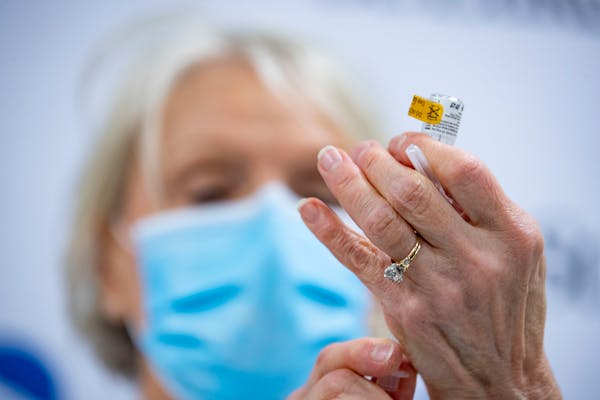Roughly 67% of Minnesotans 16 and older had received COVID-19 vaccine as of Thursday, a level of immunization that helped shield the state from the spring pandemic wave but fell short of the state goal of 70% by July 1.
While Thursday's update reflects vaccinations through June 29, any unreported shots last month are unlikely to push Minnesota past its goal, which Gov. Tim Walz announced in mid-May in response to declining numbers of new recipients.
The state, however, met President Joe Biden's challenge of providing vaccine to 70% of adults 18 and older by July 4 — reaching that exact rate Thursday, according to the U.S. Centers for Disease Control and Prevention. The White House called Walz's office Thursday with the news that the governor said is an achievement for Minnesota.
"For me, it's worth celebrating because we know what the real-world effects of this are," Walz said in an interview Thursday afternoon. "Fewer people are going to get sick."
Both goals were motivational and won't change efforts to provide shots to people who are at risk for exposure to the coronavirus that causes COVID-19, said Jan Malcolm, state health commissioner.
"People who haven't been vaccinated, they are at risk. [COVID-19] isn't gone," she said.
Minnesota has reported 605,448 coronavirus infections and 7,599 COVID-19 deaths, including 102 infections and five deaths reported Thursday. Pandemic levels are declining in the state, where the positivity rate of diagnostic testing is at a low of 1.2% and the number of COVID-19 hospitalizations is 98.
COVID-19 hospitalizations in Minnesota reached a record of 1,864 on Nov. 29 and surged again during this spring's pandemic wave to 699 on April 14.
'Remarkable' progress
"It's remarkable how much the situation has changed and how quickly over the last eight weeks or so the drop in cases and hospitalizations has been," Malcolm said. "It's significant and sustained and even we are feeling much more confident that we're in a good position now — with the very big caveat that the variants are a big deal still. There is an enormous amount of global transmission that is happening. We cannot get complacent."
Vaccinations peaked in Minnesota in April with more than 870,000 new recipients that month, according to the state's tracking data. The reported number of new recipients declined to 370,000 in May and 135,000 so far in June.
Walz said he is concerned about the slowdown in vaccinations in the 12-17 age range and the potential for viral transmission to disrupt K-12 schools in the fall. Only 37% of Minnesotans 12-15 and 49% of those 16-17 have received COVID-19 vaccine in Minnesota — leaving teenagers as a vector to spread the virus even if they are at low risk for severe COVID-19 illness themselves.
Strategies such as vaccine clinics outside the Harry Styles concert in St. Paul in September are planned, Walz said.
Clinics also will target rural and fringe suburban counties with substantially lower vaccination rates, he added.
"We have several counties that are barely at 40%," Walz said. "Come fall, if the delta variant ... is the dominant one circulating in Minnesota, we will see increased hospitalizations, sicknesses and potentially deaths in those pockets."
The delta variant identified in India is one of several more infectious variants of concern of the SARS-CoV-2 coronavirus. Genomic sequencing of a sampling of positive infections in Minnesota has identified 73 involving the delta variant.
State's ranking
Minnesota remains 20th among states with 67.1% of eligible people 12 and older receiving COVID-19 vaccine, according to the CDC data, which includes 150,000 recipients not included in the state's data. The CDC tally includes shots provided in the state by agencies such as the Department of Veterans Affairs and the Indian Health Service.
Other states that had success in rapid vaccine administration have seen their progress drop off, according to the CDC data. First-dose vaccination rates are 60.6% and 52.4% in South Dakota and North Dakota, respectively, two states that had success early on in using hospital and clinic networks to administer shots to high-priority senior citizens and health care workers.
First-dose vaccination rates among people 12 and older have reached 60.6% in Iowa and 62.6% in Wisconsin.
Jeremy Olson • 612-673-7744

